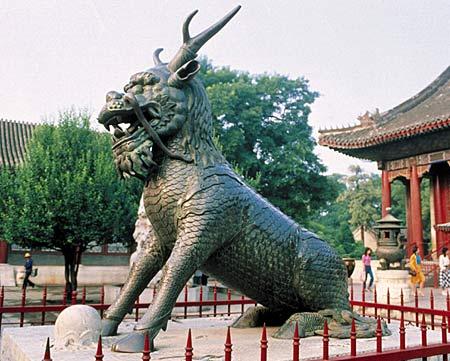
 |
| The distinctive bronze animal in front of the Hall of Benevolence and Longevity has a dragon head, lion tail, deer horns and bull hooves, and is covered with scales. (CNTV) |
In the center is the scenic area in front of the high Hill of Longevity. This area is dominated by two vertical midfield axes. The east-to-west axis is the renowned Long Corridor. The south-to-north axis starts from the middle of the Long Corridor and goes through the Paiyun Gate, Paiyun Palace, Dehui Palace and Tower of Buddhist Incense, and at last, reaches the Zhihuihai Temple on the top of the Hill of Longevity. The Tower of Buddhist Incense is the center of Summer Palace. Built on a 21-meter-high rectangular base, it is a 41-meter-high tower with eight sides, three floors and four eave layers. In the tower stand eight great rock wood pillars. The Tower is complicated in structure, and is an excellent work of classical architecture. After the original Tower was burnt down by the allied forces of the U.K and France in 1860, it was reconstructed in 1891 (Guangxu 17th year of Qing Dynasty), and cost 780,000 "liang" of silver. The reconstruction was completed in 1894 and was the largest project of the Summer Palace. The "Amitabha Buddha" was established in the Tower for the royal families to worship.
In the north is the scenic area of the back hill and lake. Although this area does not have many buildings, it has thriving forests, twisted paths and a quiet environment, and is a sharp contrast to the magnificence of scenic areas in front of the hill. A series of Tibetan buildings and the Suzhou Street of China's southern water town style all have a neat layout and look delicate.


















 Teenage crash victims were talented students
Teenage crash victims were talented students


![]()
